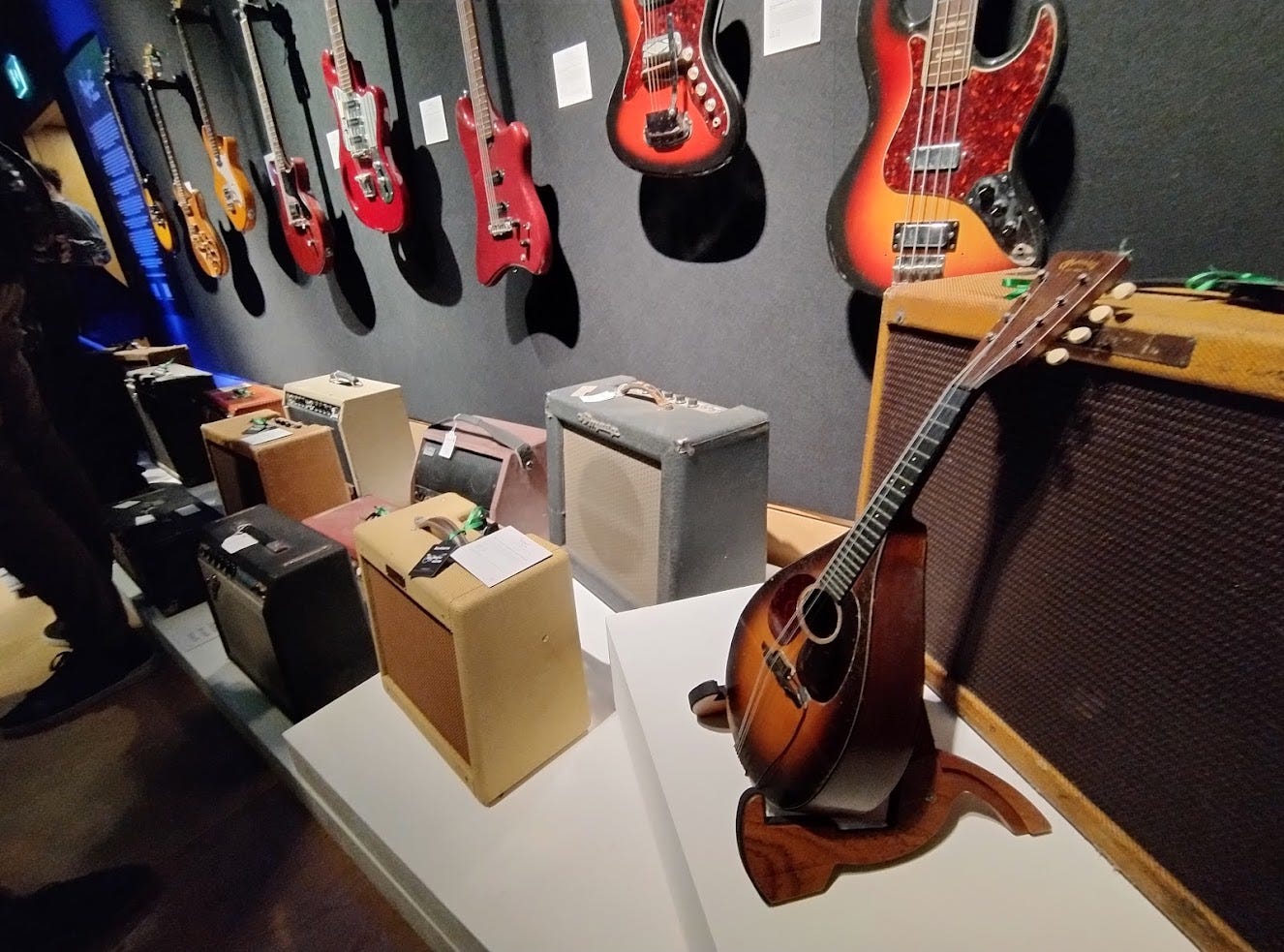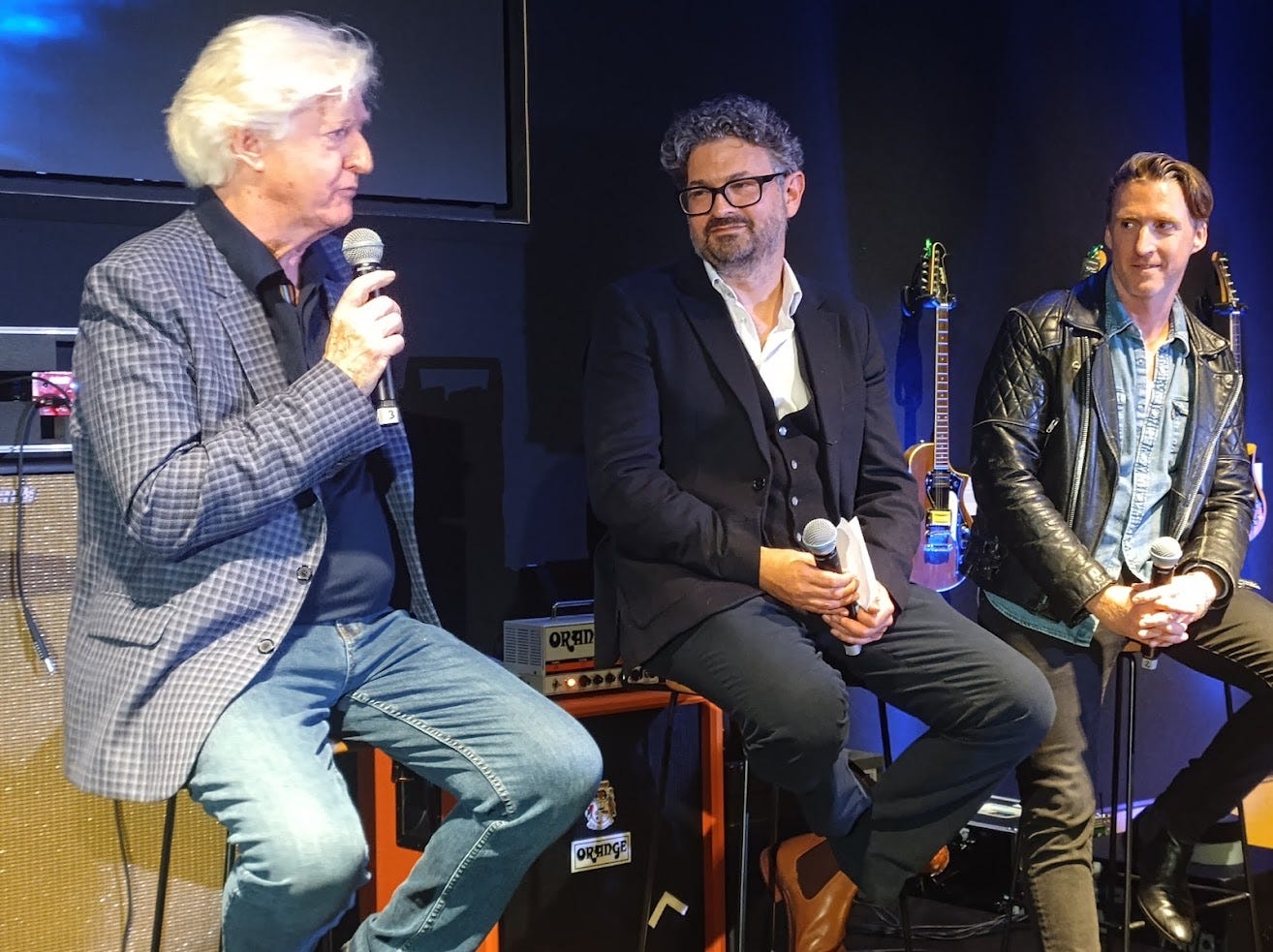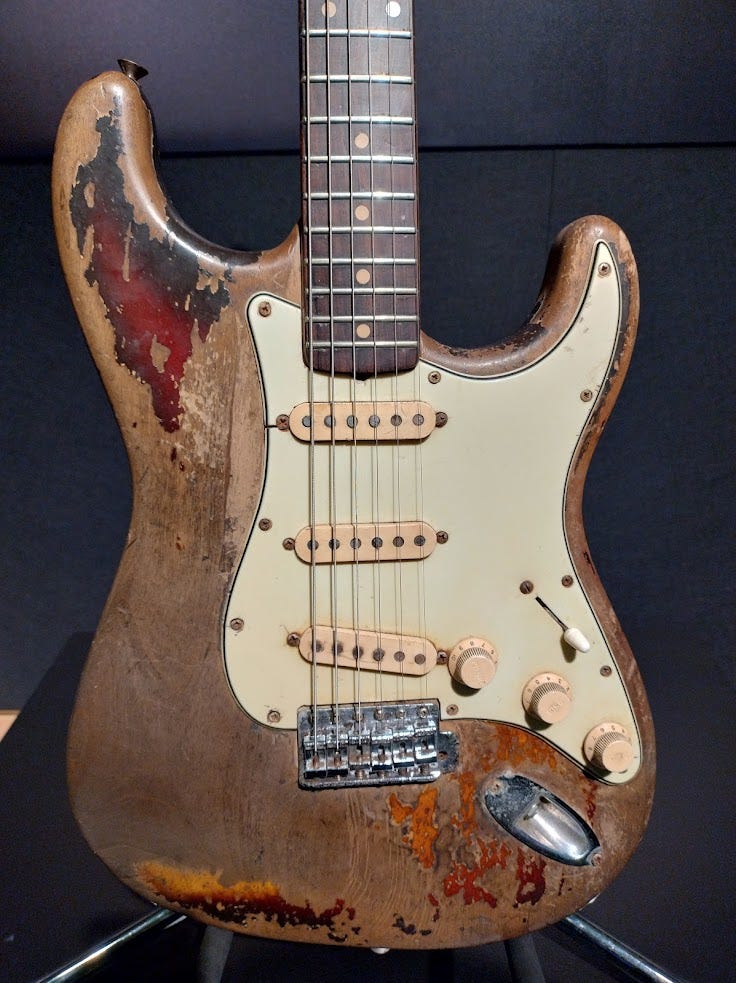RORY GALLAGHER’S GUITARS
An auction of the late Irish blues man’s gear allows for reflections on his life and music
On October 15 I was invited to an event at Bonhams auctioneers (“since 1793”) in New Bond Street. I’d never previously set foot in a British auction house and, considering what freelancers in the arts earn, I certainly wasn’t invited with the expectation that I’d bid on anything. Not that I needed to have worried, it turned out the bidding wouldn’t begin until mid-afternoon on the 17th - this was a gathering for what’s best described as ‘a celebration’.
A celebration of the life and music (and guitars and amplifiers) of Rory Gallagher, for it was Rory’s musical equipment that would be auctioned on the 17th. If you are unaware of Rory’s music (and legacy) - as his creative and commercial prowess peaked in the 1970s, this is understandable – then I’ll try and briefly explain: Rory Gallagher (1948 – 1995), was an Irish guitarist, singer and songwriter who made a huge impact as a young musician, first leading Taste, a power trio akin to Cream/Jimi Hendrix Experience, from Cork to Belfast in 1969 and then on to London. From here Taste quickly developed into a major international attraction.
Taste were heralded as rising stars by everyone from John Lennon and Eric Clapton to Lester Bangs (writing in Rolling Stone magazine he declared “it seems a shame to even suggest that Taste be classed in any way with that great puddle of British blues bands. Everybody else is just woodshedding — Taste have arrived”). Yet Rory dissolved Taste at the end of 1970. This might appear foolish considering how popular Taste had become across the past twelve months but Rory had found himself trapped in an exploitative management contract – his manager, Eddie Kennedy, paid Rory a pittance (£15 a week) whilst pocketing all the band’s recording royalties/advances and all their concert/festival fees (likely hundreds of thousands of £££).
Free of Eddie, Rory then set off solo. He played high energy, blues-influenced rock music and his dynamic performances won him legions of fans internationally. An offer from the Stones to replace the recently departed Mick Taylor saw Rory travel to Holland for the audition then leave several days later without even having jammed with the band - Keith Richards being too stoned to play (Rory was a consummate professional and never even smoked marijuana). Still, its tantalising to think what he might have added to that band had he joined.
Rory died at the far too young age of 47 after a liver transplant failed. Rory was not the stereotype self-destructive musician (alcoholism/drug addiction being the common cold amongst many rock/pop performers), instead his health deteriorated due to a mental illness which led him to becoming a chronic hypochondriac: at some point in the 1980s Rory began taking all kinds of prescription drugs – he collected prescriptions from a variety of amoral GPs like he collected guitars - for ailments he didn’t have. By self-medicating he damaged his liver.
I never met Rory or, sadly, saw him perform. He did perform in New Zealand but I was too young to attend his concerts. By the time I had settled in London in the early 90s Rory’s health problems precluded him from performing – at least to the levels he once strove for. I first became familiar with his records in the 1980s through taking a punt on a musician I’d heard older guys mention reverentially. Back then, as a teenage blues fan, I thought Rory pretty impressive. But not as impressive as – say – Stevie Ray Vaughan, who had just made a huge impact in NZ.
When Rory died so many noted musicians paid tribute to him it made me reconsider an artist who had become somewhat of a forgotten figure - I went and purchased the Irish Tour ‘74 on CD. And that album rocked my socks. What a fluid, dynamic blues player. And what joy and freedom he found in his music: listening to him sing with throaty enthusiasm then let rip on guitar I hear a soul ascending. Music was Rory’s language and he spoke it with such fluency people all over the world warmed to him. I should note, I’m not a fan of flashy guitar players, I tend to favour less-is-more players. But Rory’s finest music is full of lightness and warmth, avoiding the shrillness and posturing of many a “guitar hero”.
Reading on Rory – and speaking to those who knew him – I sense he was amongst the nicest of men. A famous musician who had no interest in fame, beyond it allowed him to make music the way he wanted to. A star who, when a concert had finished, would stand outside the venue (no matter what the weather conditions) and chat with the fans. Both Brian May and Johnny Marr have reflected on how Rory generously gave their young selves advice regarding guitar playing after performing in London and Manchester. And I’m sure many others experienced similar.
Rory surely saw music as something that brings people together in joy – he continued to perform in Northern Ireland throughout the Troubles, certain that his concerts brought light where there was darkness – and his humility can be felt in his playing.
Reflecting on Rory as an artist in 2024 it strikes me that he may have been on the autistic spectrum: he was obsessed with music at the cost of everything else, could build a guitar from scratch but couldn’t boil an egg, a gifted entertainer who brought vast audiences to their feet yet seemingly had no interest in intimate relationships. His life was based around playing music and, when not touring or recording, he struggled to find focus in his life.
Music was what gave Rory meaning and, while he excelled at this, life lived in the spotlight could not provide the stability he needed to calm his troubled mind – the dozens of guitars on display at Bonhams reflect his passion for purchasing, working on and playing his beloved six string instrument. But his musical obsessions, if serving as a cover for emotional instability, would not prove a balm: while he always nurtured his talent, Rory began to disintegrate mentally and physically - this most humble and likeable of men descended into paranoia, isolation, illness and, finally, an early grave.
A wall of Rory guitars, amps and - I think - a mandolin.
There are many sad stories in popular music and Rory’s is – while not as bitter as the experiences of, say, Billie Holiday or Esther Philips, or as pathetic of that of Hank Williams or Amy Winehouse – one that carries a huge melancholy: the blues spoke to Rory when he was a teenager and he excelled in expressing them as a musician, but his personal blues – the insecurities and unhappiness that fuelled his hypochondria – he appeared unable to share with anyone.
I learnt about Rory’s declining mental and physical health through discussing his life with Donal Gallagher (Rory’s kid brother and only sibling). Donal went from being Rory’s roadie to tour manager to manager. And then, sadly, to managing his estate – here he has ensured that only top quality Rory recordings are released while the documentaries made about Rory are thorough and serious. He is, as he always was, his brother’s keeper. And its Donal who made the decision to auction Rory’s gear.
Donal and his eldest son, Daniel Gallagher (who also now oversees Rory’s estate), were there to welcome the guests who packed into Bonhams. They then took the stage at one point to discuss why the family had, almost thirty years after Rory passed, decided to auction his gear, most of it having been held in storage since his death.
Donal & Daniel Gallagher (left & right) speak on Rory and his guitars.
Donal explained how the family had long hoped the Irish government would build a museum that celebrated Rory’s life/music in Cork and, while promises were made over the decades, these never came to fruition. After recently suffering a period of hospitalisation, Donal determined something had to be done with Rory’s gear.
Daniel noted that Rory bought most of his guitars and equipment second hand and played them with great passion – he would want other guitarists to have access to the instruments and amps so they also could plug in and play. Whether your ordinary guitarist would be able to bid for Rory’s gear in a world where the wealthy collect anything and everything once touched by rock’s late legends is another matter – the 94-lot auction would go on to raise £2.3 million.
I’m not a musician – I tried to learn guitar in my mid-teens and demonstrated only an absolute lack of musical talent – which is why I write on music. But I can appreciate the craftsmanship and history in musical instruments so enjoyed wandering around Bonhams, pint of complimentary Guinness in hand, studying Rory’s guitars and battered amplifiers.
Rory’s fabled Fender that he expressed himself on night after night.
Occupying pride of place at Bonhams is the Fender Stratocaster that Rory’s mother bought on hire purchase in 1963 for her teenage son (he was already working as a musician, playing guitar in Irish show bands). This is the instrument he used throughout his life and, arguably, was the great love of his life: its easy to recognise as Rory’s sweat (seemingly acidic) damaged the guitar’s paint so making it resemble a ruined artefact (he ensured it always played well).
At auction this fabled instrument fetched £889,000 and will be donated to the National Museum of Ireland (by Live Nation – the concert promoters). Rory didn’t get a museum devoted to his life but the instrument he loved the most, the object he made beautiful music on across his life, does receive the honour of being in a museum celebrating Irish cultural history. Which is a good thing.
Its unfortunate that the Irish government didn’t see the possibilities a Rory museum in Cork offered: if someone with vision had used Rory as the museum’s totem while developing a celebration of Irish music making around him then, surely, this could have served as a celebration of the art form the Irish are beloved for. What with all that excess tax income from allowing Google and Facebook to base themselves in Ireland (and avoid EU corporate taxes), you’d think Irish politicians might have had the wisdom to build such an institution. Music tourism, I can testify, is a growth industry.
It was not to be. Rory’s gear has gone out to the world and I hope some of it ended up with musicians who are stroking those instruments with the love and excitement Rory did, letting those vintage amps punch forth the glorious roar of a sizzling electric guitar. And Rory’s music will live on: to my ears Irish Tour ‘74 is the most exciting live album ever released. Every time I put it on my energies rise.
Thank you, Rory, for all you gave us – I just wish you had hung around longer, shared more music, found peace and happiness. And thanks to the Gallagher family, who share with Rory the trait of being extremely decent people, for looking after his estate with such love and attention to detail.
The Rory Gallagher Story is on BBC iPlayer – its narrated by Donal and a very moving tribute to his remarkable brother. https://www.bbc.co.uk/iplayer/episode/m00206t5/the-rory-gallagher-story









Met the lads from the Zac Schulze Gang this summer, touring with Samantha Fish. They are definitely keeping Rory's legend alive!